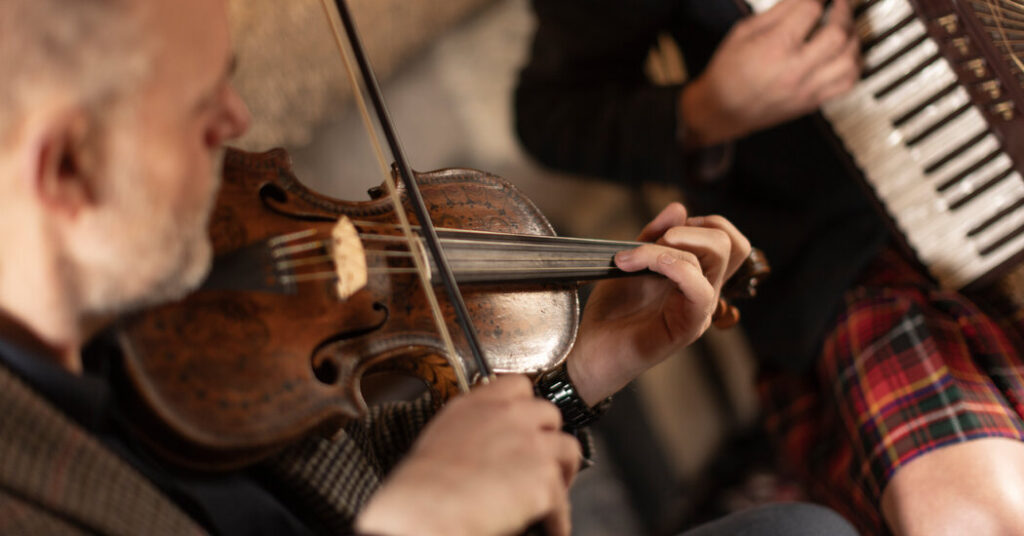Of course there will be bagpipes on Saturday, the eve of Tartan Day, when Carnegie Hall will host a lineup of stars. Among the luminaries of Scottish traditional music will be Julie Fowlis, who was featured in the soundtrack to Disney’s “Brave”; and Dougie MacLean, the singer-songwriter whose “Caledonia” has became an anthem for Scottish sports fans.
The event, “Scotland’s Hoolie in New York,” will also be the Carnegie Hall debut of an aging celebrity who flew into New York on Tuesday, accompanied by a personal bodyguard, before taking up residence at a high-security location on the Upper East Side. This V.I.P., unannounced on the program, is likely to bring goosebumps to listeners during the final performance of Robert Burns’s “Auld Lang Syne.”
The surprise guest, considered a national treasure in Scotland, has never been seen wearing tartans. The dignitary in question is a 270-year-old folk fiddle, covered in what looks like full-body floral tattoos, which belonged to the dance master William Gregg. It was Gregg who taught a 17-year-old Burns dance steps. And it was Gregg whom the young poet sought out, as he later wrote, “to give my manners a brush.” While there is no direct evidence that Burns played this fiddle, its sound would have been on his mind when he composed the jigs, reels and gracefully tripping strathspeys that continue to resound in any space where Scottish music is celebrated.
Today, the instrument is among the most popular items on show at the Robert Burns Birthplace Museum, and it is a Scottish national treasure, said Suzanne Reid, the conservator for the National Trust for Scotland who accompanied the Gregg fiddle on its trans-Atlantic journey. She was nervously monitoring the humidity levels at Freeman’s Hindman auction house, where I was granted a brief private audience.
“It is an integral part of Scottish identity,” the accordionist Gary Innes, who organized the Hoolie, said in an interview. “To have it played in the most famous concert hall built by a Scot” — Carnegie Hall’s construction was funded by the Scotland-born Andrew Carnegie — “is very special. It brings people together.” (Innes will also perform in the Hoolie with his folk-rock band Manran.)
For the teenage Burns, dance lessons with Gregg were a pivotal stage of his self-designed education and an act of rebellion against the conservative Presbyterian values of his father, a ploughman, who, Burns wrote, “had an unaccountable antipathy against these meetings.” Gregg’s dance school, at the Bachelors’ Club in rural Tarbolton, was a steppingstone on Burns’s path to becoming cultured and, Innes said, most likely a place to meet women. A stained patch on the violin’s shoulder, darkened by contact with skin and sweat, seems to embody the memory of music-making and dancing in snug country parlors.
On Saturday, the violinist Duncan Chisholm will place his chin on that spot when he plays the Gregg fiddle at Carnegie Hall. “Just to be able to hear it gives you a connection to Robert Burns,” he said. “To listen to this instrument that he listened and danced to and purportedly played as well — it’s just lovely to hold something like that in your hands.”
Made of pinewood, bird’s-eye maple and plain-cut sycamore, the violin is almost certainly the work of a Scottish luthier, Reid said. But, she added, the decorations remain something of a mystery: stylized flowers and foliage in red, black and green bordered by an ebonized toothed border and sides herringboned with leaves and seeds. Reminiscent of Turkish or Persian art, they would have stood out in the rustic interiors of Burns’s time.
The violin maker David Rattray, who did restorations on the instrument in 2016 and published a book on Scottish violin makers, said in an email that the decorations only bore a superficial resemblance to Norwegian Hardanger fiddles, which often sport elaborate pen-and-ink patterns. “The Persian-style designs on the Gregg are quite different to the more geometric and often inlaid Hardanger decorations,” he said. “I have never come across anything similar.”
For Chisholm, a fiddler and composer whose music is strongly influenced by the natural world, an instrument like the Gregg fiddle — along with the Scottish landscape — provides continuity in an evolving tradition that is still largely transmitted orally. “I see Scottish music as a big river that runs through our lives and has existed for a thousand years,” he said. “Everyone who involves himself in the tradition finds little tributaries that we spin off on in our own individual way.”
“The constants are the instruments,” he added. “We don’t know the situations this fiddle has been in, the many parties it’s been at, the conversations it’s had with people like Burns. These instruments have a story, but it’s a story that will never be told.”

